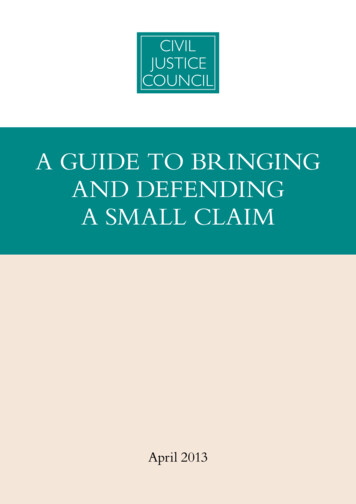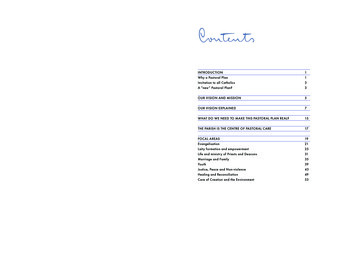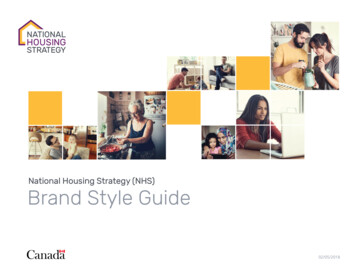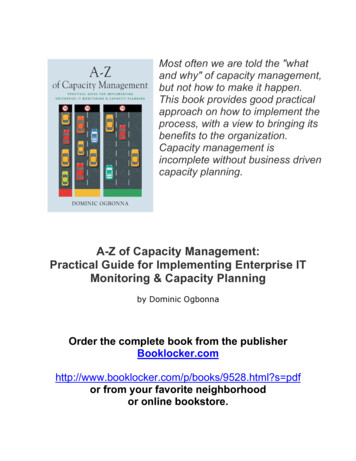
Transcription
A Guide to Bringingand Defendinga Small claimApril 2013
A guide to bringing and defending a small claim.ContentsContents1. The basics22. Help and advice43. Weighing up your options64. Starting a claim95. Defending a claim146. Progressing a claim167. Issues and evidence198. The hearing229. The court’s decision25Guidance notes – preparation for a small claim hearing27Jargon buster281
1. The basicsA guide to bringing and defending a small claim.1. The basics1.1 Who is this guide aimed at?This guide is aimed at people who are not legally trained and who want to bring or defend a small claimwithout the help of a legal adviser such as a solicitor. This is sometimes referred to as being a ‘litigant in person’.Anyone who brings a claim is called a ‘claimant’. Anyone who defends a claim is called a ‘defendant’. Someother useful terms are defined in the ‘Jargon buster’ section of this guide.1.2 What this guide coversThis guide works through the process for bringing and defending a small claim.1.3 What is a small claim?A small claim is a case that has been allocated by the court to the small claims track in the county court. Thereare three ‘tracks’: small, fast and multi-track. If you have a case which is allocated to the fast track or multi-trackyou should consult an experienced legal adviser.Cases on any of these tracks are known as ‘civil’ claims. They are nothing to do with criminal, family orinsolvency law. A civil claim is dealt with by the civil courts, the county court or the High Court.Small claims are lower value civil cases, rather than disputes of complexity or high value. Typically smallclaims are claims for compensation for faulty services provided, for example, by builders, dry cleaners etc, orcompensation for faulty goods such as washing machines, televisions etc, or for unpaid bills. They also includedisputes between landlords and tenants – for example, rent arrears or compensation for not doing repairs, roadtraffic accident claims or wages owed.You can’t choose which track you want your claim to be heard on – a district judge makes that decision as partof case management based on the amount you are claiming and the complexity of your claim. You will beasked to complete a Directions Questionnaire setting out your preference and (see section 6.3 below).When deciding if a case is suitable for the small claims track, the court will generally look at two things:1. Financial value of the caseIf the value of a case is 10,000 or less, it will generally be allocated to the small claims track. However,there are two exceptions:1. If it is a personal injury claim, it will be allocated to the small claims track only if the value of theclaim for the personal injuries is not more than 1,000.2. If the claimant is a tenant, and is claiming against their landlord because they want their landlord tocarry out repairs or other work to the premises and the cost of the repairs or work is 1,000 or less,the case will be allocated to the small claims track.Even if the value of the case is more than 10,000, the court could allocate the case to the small claimstrack.2. ComplexityIf the case is of a low value but is complicated, the judge might decide it needs to go to another track for afull hearing. You may make submissions about this in the Directions Questionnaire.2
A guide to bringing and defending a small claim.1. The basicsXxxxxxxxx1.4 What is not a small claimA claim for harassment or unlawful eviction relating, in either case, to residential premises will not be allocatedto the small claims track.1.5 CostsThere are three kinds of costs or expenses involved in court proceedings:1. There are court fees. These are what you pay the court, for example, in return for them processing a formor arranging court time for a hearing. It’s the way people who use the courts contribute to the cost ofrunning the courts. See section 4.7 below for more information. If you win a small claim, the other partywill generally be ordered to reimburse your court fees.2. There are reasonable travelling expenses, loss of earnings (although the amount that can be allowed for theseis restricted by the court rules for the small claims track) and expert’s fees (if the court has allowed an expertto be instructed). If you win a small claim, the other party will generally be ordered to reimburse thesefor you, but of course if you lose you may be ordered to pay the amount awarded to the successful party.3. Then there are legal costs (often just referred to as ‘costs’). These are what solicitors charge for the legalwork they do. The small claims track works differently to the other two tracks when it comes to costs.Orders for one side to pay the other side’s costs are unusual – it is usually the case that even if you aresuccessful you will bear your own. This is different to the other tracks where it is usually the case that theloser pays the winner’s costs. For this reason, most people bringing or defending a small claim representthemselves (or have free support from a friend or ‘lay representative’ or someone legally trained from,e.g. the Citizens Advice Bureaux) rather than instruct a solicitor. However, you should be aware that ifyou bring a small claim and are unsuccessful, or as the defendant in a small claim you put the other sideto huge trouble and then lose, the court has a discretion to make an order for you to pay the costs that theother side has incurred if you have acted unreasonably.1.6 What are the Civil Procedure Rules?These are the court rules you have to follow. They explain what you need to do when. You may hear lawyerstalk about the ‘CPR’. What they’re referring to are these rules. You need to follow the ones that apply to yourcase. If you don’t follow these rules it could cost you money or cause you to lose your case.It’s not like a book – you don’t have to start at the beginning and read all the way through to the end. You needto pick out the rules that are relevant to your case.You can find the relevant rules for small claims (Rule 27) il/rules/part27An individual rule often comes with one or more additional bits of guidance, called ‘practice directions’. Theone that applies to small claims (Practice Direction 27) can be found il/rules/pd part27#id35858301.7 What additional help is available for court users with a disability?If you have a disability which makes going to court or communicating difficult, contact the Customer ServiceOfficer of the court. If the Customer Service Officer of the court cannot help you, you can contact theDisability Helpline on 0800 358 3506 between 9 am and 5 pm Monday to Friday. Calls to this number are free.If you are deaf or hard of hearing, you can use the Minicom service on 0191 478 1476.There are special rules that may apply to a party with a mental disability. If this renders them incapable ofconducting the proceedings they are treated as a ‘protected party’ and a suitable responsible adult must beappointed to represent them as a ‘litigation friend’. Rule 21 of the CPR deals with this.3
2. Help and adviceA guide to bringing and defending a small claim.2. Help and advice2.1 Legal aidBefore starting your claim, you should check whether you are entitled to legal aid. Legal aid pays for adviceto help people understand their legal obligations and if necessary enforce their legal rights. It is only availablefor certain types of claim and is means-tested. For more information about help with legal costs, go to:www.adviceguide.org.uk/england/law e/law legal system e/law taking legal action e/help with legal costs.htm.2.2 Free legal adviceEven if you are not entitled to legal aid and you can’t afford a solicitor, this does not mean you have to strugglewithout any help. Are you sure you know what the law says and means? Do you understand how it applies toyour case? Are you certain you know what legal procedure to follow? If not, you’re not alone! Most peopleneed advice – usually more than once in their case. You could to a Citizens Advice Bureau or legal drop-inclinic – these are free of charge. A full list of them can be found here: .uk/going-to-courtCitizens Advice onlineThe Citizens Advice Bureau offers advice online on a wide range of topics including: Consumer advice – cars and vehicles, builders and home improvements, phones, TV, internet andcomputers, furniture, household goods and clothing, travel, leisure and food, common problems withproducts, different ways of buying, professional and financial services, common problems with serviceproviders, energy and water supply, post and taking action about consumer problems. Benefits.Work – rights at work, problems at work, work coming to an end, time off work, discrimination, healthand safety at work, being self-employed or looking for work and young people. Debt and money. Relationships. Housing. Law and rights – civil rights, the legal system, immigration and society. Discrimination. Tax – income tax, inheritance tax, council tax and advice for pensioners. Healthcare. Education.4
A guide to bringing and defending a small claim.2. Help and adviceOther court forms and guidesEX306 The small claims track in civil courts.(www.smallclaims.me.uk/smallclaims forms/ex306.pdf )EX301 I’m in a dispute – what can I do?(www.smallclaims.me.uk/smallclaims forms/ex301 0406.pdf )EX302 How do I make a court claim?(www.smallclaims.me.uk/smallclaims forms/ex302 0406.pdf )EX304 I’ve started a claim in court – what happens next?(www.smallclaims.me.uk/smallclaims forms/ex304 0406.pdf )5
3. Weighing upyour optionsA guide to bringing and defending a small claim.3. Weighing up your options3.1 Does my problem need to be dealt with by a court?Before starting a claim it is helpful to think through what has happened and what action you can and shouldtake – these are not necessarily the same thing. Going to court is a last resort. It costs money, takes time and canbe risky. Although it is one potentially useful option it is important to consider whether there might be betterroutes you can take which may resolve your problem.You must have a legal basis for starting your claim. This is what the law calls a ‘cause of action’. For example, ifyou buy a washing machine that is faulty the shop that sold it to you may have broken their contract to supplyyou with goods that are satisfactory quality. You have a ‘cause of action’. But, if you choose to jump off a rockinto the sea and injure yourself as a result, this is no one’s fault but your own. In these circumstances, you don’thave a ‘cause of action’. Without a cause of action you don’t have a case you can ask a court to decide; you justhave a problem you need to resolve in another way. Just because you feel something is wrong or unjust doesn’tmean you can start court proceedings.3.2 Do nothing?Consider whether it would be best for you to actually do nothing. It might be that, on balance, you don’t thinkthe problem is worth spending time, money and energy on. Even if you are successful in obtaining a courtjudgment there is no certainty that you will recover the amount awarded. Always consider whether the otherparty is worth suing.3.3 Attempts to avoid courtIf you end up taking your claim to court the judge will want to see that you have attempted to avoid the needto come to court by trying one, or all, of the following first: Talking to the other party or sending them a letter to try to resolve the issue – in certain circumstances alsocalled a ‘letter before action’ – see ‘Pre-Action Protocols’ below. Mediation – this is where a third party gets you both together and helps you to talk through the problem andreach a resolution. This is one form of ‘Alternative Dispute Resolution’. You can find further informationabout mediation on the Advice Services Alliance website at: www.asauk.org.uk.There might be a relevant ombudsman, or arbitration service if you are a business, that can intervene in yourcase. An ombudsman is a person who has been appointed to look into complaints about an organisation. Usingan ombudsman is a way of trying to resolve a complaint without going to court. For more information go to:www.adviceguide.org.uk/england/law e/law civil rights e/law complaints e/how to use an ombudsman.htm.You could also consider asking one of your local authority councillors if they can assist you without going tocourt. They can’t offer you legal advice but they might be able to give you practical information. You can findout who your councillors are by visiting: www.writetothem.com.3.4 Pre-Action ProtocolsPre-action protocols explain what to do and how to behave before you start your claim. You can find them protocol. You should follow the relevant pre-action protocol foryour type of claim. For example, if you are claiming compensation for an injury following an accident you willfollow the one about personal injury claims.6
A guide to bringing and defending a small claim.3. Weighing upyour options3.5 I think my issue needs to be dealt with by a court. Will I win?First, you need to assess the merits of your claim. This is to test whether, if you do go to court, you stand muchof a chance of success. If you are feeling angry about what has happened it can be hard, even with the best willin the world, to objectively assess the merits of your claim. Sometimes a case might be very strong on the factsbut weak in legal terms.It is a good idea to discuss the problem with someone who is not involved to get a second opinion. Friends andfamily are a good source of moral support but think about whether you might also benefit from speaking tosomeone totally outside the situation who can give you a full and frank view. You could go to one of the legaladvice clinics mentioned above.3.6 Strategy – the seven stepsIf you decide to issue a claim as a litigant in person, you need a strategy:1. What’s your problem?2. Know your rights.3. Know what you want.4. Know who to speak to.5. Communicate clearly.6. Be organised.7. Know when to get help.1. What’s your problem? What is the heart of the problem? Is it something that a court can help with or would it be better to use Alternative Dispute Resolution? Are there other issues going on that could be dealt with separately?2. Know your rights Where can you get reliable and trustworthy information from? See chapter 2.3. Know what you want What harm have you suffered? What remedy are you looking for? Have you lost money, suffered damage to property or injury to yourself? Can you put a figure on it? Or is it that you haven’t lost anything but you’re angry with the other side and feel an injustice hasoccurred? Would it be enough for the other side to acknowledge they’ve done something wrong andapologise? In which case, do you need to go all the way to court?4. Know who to speak to Have you explained the problem to the other side in person or in writing to give them the opportunity toput it right? If so, have you spoken to the right person? If it is a company, have you spoken to a manager? If the other side have instructed solicitors, you must write to the solicitors direct and not to the otherparty personally.7
3. Weighing upyour optionsA guide to bringing and defending a small claim.5. Communicate clearlyWhen communicating, in writing or in person, try to be: Clear – what is the purpose of your communication? Concise – stick to the point and keep it brief. Concrete – you need to give enough details so that the reader/listener can follow but don’t go overboard. Correct – make sure you are accurate in what you are saying. Coherent – try not to get angry or emotional. Will you come across better in an e-mail or letter ratherthan in person or over the phone? Plan in advance what you want to say. Complete – have you given enough information for the reader/listener to take appropriate action? Courteous – don’t be rude or ‘shoot the messenger’. The best way to get an outcome you are happy withis to be persuasive and to gently bring people over to your way of seeing things with evidence and politeargument, not to be angry and aggressive.Always remember that any communication you send or receive – unless marked as ‘without prejudice’ (see‘Jargon buster’ section) – may subsequently be seen by the court.6. Be organised Think about what documents you might need to back up your position. Keep a record of correspondence with the other side. Make and keep copies of court documents, receipts, orders etc. Take plenty of copies of forms with you to court in case the court needs spares.7. Know when to ask for helpDon’t get in over your head. If you are worried, seek help – see chapter 2.8
A guide to bringing and defending a small claim.4. Starting a claim4. Starting a claim4.1 Where and when do I begin?First, you need to follow the relevant pre-action protocol (if there is one) – see section 3.4 above.Local county courtYou can start a small claim at your local county court – or any other county court of your choice. You can findyour local court, its contact details and opening times here: http://hmctscourtfinder.direct.gov.uk/HMCTS. Tostart a claim at your local county court you need to complete a form called a ‘claim form’.Money Claim OnlineIf someone owes you money and won’t pay you can use an online service called ‘Money Claim Online’(MCOL) at: www.moneyclaim.gov.uk. Guidance materials are available at: ov.uk/make-court-claim-for-moneyPossession Claim OnlineThere is also a special online service for people wanting to claim or respond to a claim for rent or mortgagearrears at: www.possessionclaim.gov.uk/pcol.You will need to start your claim before its limitation period runs out. Limitation periods differ depending onthe cause of action. They are set out in statute. For breach of contract claims the time limit is six years from the date of breach. For breach of a deed (adocument that is similar to a contract but signed in a special way with witnesses) the time limit is usually12 years. There is a standard three-year time limit for cases involving personal injury claims. The limit applies fromthe date of the accident or from date of knowledge that you have been injured, whichever is the latest. In cases of professional negligence the time limit is generally six years from the date of the negligent act.The best way to be sure you are within the time limit is to check with a legal adviser.4.2 What is a claim form and how do I complete it?A claim form is the form you need to fill in to start a claim in your local county court. It is given the code ‘N1’by the court service.For most claims, the form to use is this nder/forms/n001-eng.pdfYou can find notes explaining how to complete this form inder/forms/n001a-eng.pdfAnd in Welsh and English inder/forms/n001a-bil.pdfRelevant rules: How to start proceedings – The claim rules/civil/rules/pd part07a9
4. Starting a claimA guide to bringing and defending a small claim.4.3 How do I assess the ‘Amount Claimed’?Money claimIf you are claiming a fixed amount of money (a ‘specified amount’) write the amount in the box at the bottomright-hand corner of the claim form against ‘amount claimed’.If you are not claiming a fixed amount of money (an ‘unspecified amount’) under ‘Value’ write ‘I expect torecover not more than 10,000’. If you are not able to put a value on your claim, write ‘I cannot say how much Iexpect to recover’.Personal injuriesIf your claim is for ‘not more than 10,000’ and includes a claim for personal injuries, you must also write‘My claim includes a claim for personal injuries and the amount I expect to recover as damages for pain, suffering and loss ofamenity is . . .’ followed by either: ‘not more than 1,000’ or‘more than 1,000’Housing disrepairIf your claim is for ‘not more than 10,000’ and includes a claim for housing disrepair relating to residentialpremises, you must also write ‘My claim includes a claim against my landlord for housing disrepair relating to residentialpremises. The cost of the repairs or other work is estimated to be . . .’ followed by either: ‘not more than 1,000’ or‘more than 1,000’If, within this claim, you are making a claim for other damages, you must also write ‘I expect to recover asdamages’ followed by either: ‘not more than 1,000’ or‘more than 1,000’InterestYou can claim interest on the money you’re owed but you must expressly state the basis on which you are doingso. It may be a contractual claim for interest but will usually rely upon the County Courts Act 1984 section 69.This statutory rate is 8% per year at present. To work out the interest, follow these steps:Step one: work out the yearly interestTake the amount you’re claiming for and multiply it by 0.08 (that is, 8%).For example, if you were claiming for 1,000, the annual interest on this would be 80 (1000 x 0.08 80).Step two: work out the daily interestDivide your yearly interest from step one by 365 (the number of days in a year).In the example above, you would divide 80 by 365 to get the daily interest, which would be about 22p a day(80/365 0.2192).Step three: work out the total amount of interestMultiply the daily interest from step two by the number of days the debt has been owed to you.In the above example, after 50 days this would be 10.96 (50 x 0.2192).10
A guide to bringing and defending a small claim.4. Starting a claim4.4 What are the ‘Particulars of Claim’?There is a section on the second page of the claim form for entering the ‘Particulars of Claim’. This spaceshould be used to set out the details of the claim, but if there is not enough room they can be set out on aseparate piece of paper.Particulars of claim should not include an exhaustive account of all evidence that you want to use to supportyour claim; this will be set out in later documents. Try to strike a balance between being brief and giving thecourt and defendant enough information to know what your complaint is. This is what a simple might looklike if included on the claim form:Particulars of Claim (attached) (to follow)1. The defendant has been a personal friend of mine since 2005.2. The defendant is the owner of a cafe called ‘Tea and Toast’ and, sometime in March or early April 2011,asked me for a loan to help her business.3. I agreed to lend the defendant 4,500. This was an oral agreement. One of the terms of the agreement wasthat the defendant would repay me the sum of 500 in interest on top of the loan of 4,500. We agreed thatthe defendant would repay the loan and agreed interest at the rate of 500 a month starting in July 2011.This was when the cafe was due to open.4. I transferred the sum of 4,500 to the defendant on 30th April 2011 and this shows on my bank statementas transaction reference: 735462912800B.5. The opening of the cafe was delayed. It finally opened in August 2011. I received the first instalment of 500from the defendant towards the end of August 2011.6. I then had to chase the defendant for further payments. I received a further 200 from the defendant at theend of September 2011 and 100 in October 2011. In total I have received 800 from the defendant.7. Since then I have been chasing repayments from the defendant but without success. I sent a letter beforeclaim to the defendant on 5th January 2012 but got no reply. The defendant keeps telling me that the letteris with her solicitor and blames her solicitor for the delay.8. I am still owed 4,200 by the defendant.AND the claimant claims:1. The outstanding loan agreement sum of 4,200.2. Interest pursuant to section 69 of the County Court Act 1984 at an annual rate of 8%.3. Costs.4.5 What documents will I need to file with the claim form?In some circumstances, additional documents need to be attached to the Particulars of Claim. For example,if the claim is for personal injuries and you are relying on a medical report a copy of that report should beattached the Particulars of Claim.4.6 Where do I go to file the claim form?‘Filing’ means delivering a copy of a document to the court.If the claim is for a sum of money then you must send two copies of the claim form to the County CourtMoney Claims Centre, PO Box 527, Salford, M5 0BY. Keep a copy for yourself too.11
4. Starting a claimA guide to bringing and defending a small claim.If it is a claim for anything other than money you should send or take two copies of the claim form to thecounty court where you want to start the claim. Keep a copy for yourself too.The Court Centre or county court will impress a seal on the claim form and in most cases serve it on thedefendant (see more on service in 4.9 below). You will know whether you have issued (started) your claimsuccessfully when the court sends you a Notice of Issue.4.7 How much will it cost me? (Figures correct as at September 2012)When bringing a small claim, the claimant pays various court fees at different stages of the process. Detailedinformation on fees is contained in Form EX050. If you win the claim you will usually be awarded the courtfees against the defendant although recovery may depend upon enforement.1. Fee to issue the claimThere is a fee to pay when you issue the claim form. To issue a claim for money, as at September 2012 thefollowing fees will be payable based on the amount claimed, including interest:Court issued claimMoney claim onlineUp to 300 35 25 300.01 – 500 50 35 500.01 – 1,000 70 60 1,000.01 – 1,500 80 70 1,500.01 – 3,000 95 80 3,000.01 – 5,000 120 100Etc.To issue a claim for something other than money, including possession, the following fees will be payablebased on where you start your claim: County court – 175 Possession Claims Online (PCOL) – 100. PCOL can only be used for possessions concerning rent ormortgage arrears2. Directions Questionnaire feeWhen you file the Directions Questionnaire you will need to pay another fee. For small claims, where theclaim is more than 1,500, the fee is 40. Where the claim is under 1,500 there is no fee payable.3. Hearing feeThe hearing fee depends on the value of the claim:Hearing feeUp to 300 25 300.01 – 500 55 500.01 – 1,000 80 1,000.01 – 1,500 110 1,500.01 – 3,000 165 3,000.01 – 5,000 325Etc.Other fees might apply as the claim progresses.12
A guide to bringing and defending a small claim.4. Starting a claim4.8 Might I be entitled to a fee exemption or remission?You may be entitled to fee exemption/remission – for example, if you are on means-tested state benefits. Checkyour eligibility using Form EX160a /forms/ex160a-eng.pdf ).4.9 ‘Serving’ the claim formEither the claimant or the court must give the defendant a copy of the claim form. This is known as ‘service’.The service of court documents is a tricky area of law. There are lots of special rules about how and when itmust be done. It’s easy to make a mistake. If you don’t serve your claim form (or other court documents) in thecorrect way and at the right time, you may need to seek discretionary relief from the court.Important informationService of the claim form must take place within four months of the date that the claim form is issued (sealed) bythe court. In some circumstances you might need extra time to complete the particulars of claim. You can sendthe particulars of claim to the defendant separately, but no later than 14 days after you have sent the claim form.Usually the court will serve the claim form by sending it to the defendant by first class post. This is the easiestoption for you. The defendant will be deemed to receive it on the second business day after posting.4.10 How can I serve the claim form?As the c
1. i f it is a personal injury claim, it will be allocated to the small claims track only if the value of the claim for the personal injuries is not more than 1,000. 2. i f the claimant is a tenant, and is claiming a











